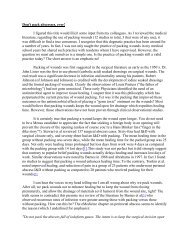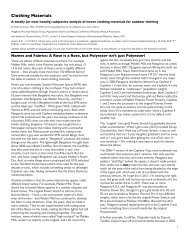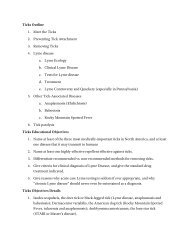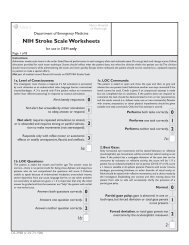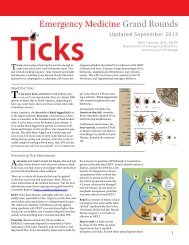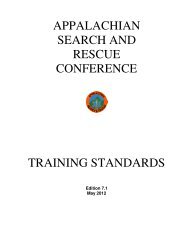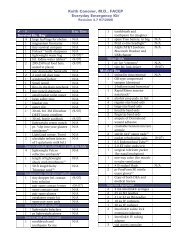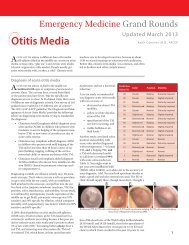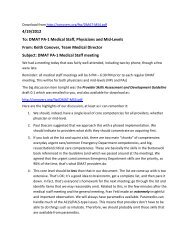pneumothorax BTS guidelines for the management of spontaneous
pneumothorax BTS guidelines for the management of spontaneous
pneumothorax BTS guidelines for the management of spontaneous
You also want an ePaper? Increase the reach of your titles
YUMPU automatically turns print PDFs into web optimized ePapers that Google loves.
Downloaded from thorax.bmj.com on 17 August 2008<br />
ii50<br />
Henry, Arnold, Harvey<br />
Audit points<br />
• Proportion <strong>of</strong> patients treated by (a) simple observation, (b)<br />
aspiration, and (c) chest drains and <strong>the</strong>ir appropriateness<br />
(relative to <strong>the</strong> <strong>guidelines</strong>) and outcome (in terms <strong>of</strong><br />
recurrence rates, complications, and lengths <strong>of</strong> stay in hospital)<br />
• Number <strong>of</strong> chest drains clamped and <strong>the</strong> reasons <strong>for</strong> this.<br />
• Referral rates to physicians and surgeons and <strong>the</strong> timing <strong>of</strong><br />
such referrals.<br />
• Use <strong>of</strong> analgesics and local anaes<strong>the</strong>tics.<br />
• Follow up rates<br />
Future potential areas <strong>for</strong> research<br />
• Prospective randomised controlled trials comparing:<br />
• simple observation versus aspiration ± tube drainage<br />
<strong>for</strong> primary pneumothoraces larger than 2 cm on <strong>the</strong><br />
chest radiograph;<br />
• use <strong>of</strong> small ca<strong>the</strong>ter/Heimlich valve kits versus intercostal<br />
tube drainage following failed aspiration in<br />
primary pneumothoraces;<br />
• small ca<strong>the</strong>ter aspiration (CASP) versus conventional<br />
aspiration or tube drainage;<br />
• VATS versus open thoracotomy <strong>for</strong> <strong>the</strong> difficult <strong>pneumothorax</strong>.<br />
• Use <strong>of</strong> suction with regard to its timing and optimal mode.<br />
• Comparison <strong>of</strong> “clamping” and “ non-clamping” strategies<br />
after cessation <strong>of</strong> air leak.<br />
<strong>the</strong>y will prove to be as successful and possibly replace simple<br />
aspiration followed by immediate removal <strong>of</strong> <strong>the</strong> ca<strong>the</strong>ter as<br />
recommended in <strong>the</strong>se <strong>guidelines</strong>.<br />
Several aspects <strong>of</strong> <strong>management</strong> that were not previously<br />
covered are now included. These include <strong>the</strong> place <strong>of</strong> CT scanning<br />
in diagnosis, which patients to refer <strong>for</strong> surgery, a discussion<br />
<strong>of</strong> surgical techniques, and issues such as intercostal tube<br />
size and <strong>the</strong> place <strong>of</strong> suction and pleurodesis. Complex<br />
scenarios including tension <strong>pneumothorax</strong>, subcutaneous<br />
emphysema, <strong>pneumothorax</strong> in HIV disease and adult CF are<br />
also discussed. It is hoped that <strong>the</strong>se changes build on <strong>the</strong><br />
clinical benefits produced by <strong>the</strong> first set <strong>of</strong> <strong>guidelines</strong><br />
which—if adhered to—should, we calculate, prevent approximately<br />
7000 unnecessary chest drain insertions every year in<br />
<strong>the</strong> UK.<br />
.....................<br />
Authors’ affiliations<br />
M Henry, Department <strong>of</strong> Respiratory Medicine, The General Infirmary at<br />
Leeds, Great George Street, Leeds LS1 3EX, UK<br />
T Arnold, Medical Chest Unit, Castle Hill Hospital, Cottingham, North<br />
Humberside HU16 5JQ, UK<br />
J Harvey, Department <strong>of</strong> Respiratory Medicine, Southmead Hospital,<br />
Bristol BS10 5NB, UK<br />
REFERENCES<br />
1 Light RW. Pneumothorax. In: Pleural diseases. 3rd ed. Baltimore:<br />
Williams and Wilkins, 1995: 242–77.<br />
2 Laennec RTH. Trait de l’auscultation mediate et des maladies des<br />
poumons et du coeur. Tome Second. Paris, 1819.<br />
3 Kjaergard H. Spontaneous <strong>pneumothorax</strong> in <strong>the</strong> apparently healthy.<br />
Acta Med Scand (Suppl) 1932;43:1–159.<br />
4 Melton LJ, Hepper NCG, Of<strong>for</strong>d KP. Incidence <strong>of</strong> <strong>spontaneous</strong><br />
<strong>pneumothorax</strong> in Olmsted County, Minnesota: 1950–1974. Am Rev<br />
Respir Dis 1979;29:1379–82. [III]<br />
5 Bense L, Wiman LG, Hedenstierna G. Onset <strong>of</strong> symptoms in<br />
<strong>spontaneous</strong> <strong>pneumothorax</strong>: correlations to physical activity. Eur J Respir<br />
Dis 1987;71:181–6. [III]<br />
6 Gupta D, Hansell A, Nichols T, et al. Epidemiology <strong>of</strong> <strong>pneumothorax</strong> in<br />
England. Thorax 2000;55:666–71. [III]<br />
7 Donahue DM, Wright CD, Viale G, et al. Resection <strong>of</strong> pulmonary blebs<br />
and pleurodesis <strong>for</strong> <strong>spontaneous</strong> <strong>pneumothorax</strong>. Chest<br />
1993;104:1767–9. [IIb]<br />
8 Lesur O, Delorme N, Frogamet JM, et al. Computed tomography in <strong>the</strong><br />
aetiological assessment <strong>of</strong> idiopathic <strong>spontaneous</strong> <strong>pneumothorax</strong>. Chest<br />
1990;98:341–7. [IIa]<br />
9 O’Hara VS. Spontaneous <strong>pneumothorax</strong>. Milit Med 1978;143:32–5.<br />
[III]<br />
10 Jansveld CA, Dijkman JH. Primary <strong>spontaneous</strong> <strong>pneumothorax</strong> and<br />
smoking. BMJ 1975;4:559–60. [IIa]<br />
11 Bense L, Eklund G, Odont D, et al. Smoking and <strong>the</strong> increased risk <strong>of</strong><br />
contracting <strong>pneumothorax</strong>. Chest 1987;92:1009–12. [IIa]<br />
12 Schramel FM, Meyer CJ, Postmus PE. Inflammation as a cause <strong>of</strong><br />
<strong>spontaneous</strong> <strong>pneumothorax</strong> and emphysematous-like changes: results <strong>of</strong><br />
bronchoalveolar lavage. Eur Respir J 1995;8:397s. [IIb]<br />
13 Wi<strong>the</strong>rs JN, Fishback M.E, Kiehl PV, et al. Spontaneous <strong>pneumothorax</strong>.<br />
Am J Surg 1964;108:772–6. [IV]<br />
14 Sadikot RT, Greene T, Meadows K, et al. Recurrence <strong>of</strong> primary<br />
<strong>pneumothorax</strong>. Thorax 1997;52:805–9. [III]<br />
15 West JB. Distribution <strong>of</strong> mechanical stress in <strong>the</strong> lung, a possible factor in<br />
localisation <strong>of</strong> pulmonary disease. Lancet 1971;i:839–41. [IIb]<br />
16 Smit HJM, Chatrou M, Postmus PE. The impact <strong>of</strong> <strong>spontaneous</strong><br />
<strong>pneumothorax</strong> and its treatment on <strong>the</strong> smoking behaviour <strong>of</strong> young adult<br />
smokers. Respir Med 1998;92:1132–6. [III]<br />
17 Lippert HL, Lund O, Blegrad S, et al. Independent risk factors <strong>for</strong><br />
cumulative recurrence rate after first <strong>spontaneous</strong> <strong>pneumothorax</strong>. Eur<br />
Respir J 1991;4:324–31. [III]<br />
18 Videm V, Pillgram-Larsen J, Ellingsen Ø, et al. Spontaneous<br />
<strong>pneumothorax</strong> in chronic obstructive pulmonary disease: complications,<br />
treatment and recurrences. Eur J Respir Dis 1987;71:365–71. [III]<br />
19 Miller AC, Harvey JE. Guidelines <strong>for</strong> <strong>the</strong> <strong>management</strong> <strong>of</strong> <strong>spontaneous</strong><br />
<strong>pneumothorax</strong>. BMJ. 1993;307:114–6. [IV]<br />
20 Soulsby T. British Thoracic Society <strong>guidelines</strong> <strong>for</strong> <strong>the</strong> <strong>management</strong> <strong>of</strong><br />
<strong>spontaneous</strong> <strong>pneumothorax</strong>: do we comply with <strong>the</strong>m and do <strong>the</strong>y work?<br />
J Accid Emerg Med 1998;15:317–21. [III]<br />
21 Selby CD, Sudlow MF. Deficiencies in <strong>the</strong> <strong>management</strong> <strong>of</strong> <strong>spontaneous</strong><br />
pneumothoraces. Scot Med J 1994;39:75–6. [III]<br />
22 Yeoh JH, Ansari S, Campbell IA. Management <strong>of</strong> <strong>spontaneous</strong><br />
<strong>pneumothorax</strong> : a Welsh survey. Postgrad Med J 2000;76:496–9. [III]<br />
23 Grimshaw JM, Russell IT. Effect <strong>of</strong> clinical <strong>guidelines</strong> on medical<br />
practice: a systematic review <strong>of</strong> rigorous evaluation. Lancet<br />
1993;342:1317–21. [IIb]<br />
24 Bero LA, Grilli R, Grimshaw JM, et al. Closing <strong>the</strong> gap between research<br />
and practice: an overview <strong>of</strong> systematic reviews <strong>of</strong> interventions to<br />
promote <strong>the</strong> implementation <strong>of</strong> research findings. BMJ 1998;317:465–8.<br />
[Review]<br />
25 Grilli R, Lomas J. Evaluating <strong>the</strong> message: <strong>the</strong> relationship between<br />
compliance rate and <strong>the</strong> subject <strong>of</strong> a practice guideline. Med Care<br />
1994;32:202–13. [IV]<br />
26 Woolf SH, Grol R, Hutchinson A, et al. Potential benefits, limitations and<br />
harms <strong>of</strong> clinical <strong>guidelines</strong>. BMJ 1999;318:527–30.<br />
27 Agency <strong>for</strong> Health Care Policy and Research. Acute pain<br />
<strong>management</strong>, operative or medical procedures and trauma. Clinical<br />
practice <strong>guidelines</strong>. Publication no. 92-0032. Rockville, Maryland, USA:<br />
Agency <strong>for</strong> Healthcare Policy and Research Publications, 1992.<br />
28 Petrie GJ, Barnwell E, Grimshaw J, on behalf <strong>of</strong> <strong>the</strong> Scottish<br />
Intercollegiate Guidelines Network. Clinical <strong>guidelines</strong> criteria <strong>for</strong><br />
appraisal <strong>for</strong> national use. Edinburgh: Royal College <strong>of</strong> Physicians,<br />
1995.<br />
29 Vail WJ, Alway AE, England NJ. Spontaneous <strong>pneumothorax</strong>. Dis Chest<br />
1963;38:512–5. [III]<br />
30 Serementis MG. The <strong>management</strong> <strong>of</strong> <strong>spontaneous</strong> <strong>pneumothorax</strong>. Chest<br />
1970;57:65–8. [III]<br />
31 Wait MA, Estrera A. Changing clinical spectrum <strong>of</strong> <strong>spontaneous</strong><br />
<strong>pneumothorax</strong>. Am J Surg 1992;164:528–31. [III]<br />
32 Tanaka F, Itoh M, Esaki H, et al. Secondary <strong>spontaneous</strong> <strong>pneumothorax</strong>.<br />
Ann Thorac Surg 1993;55:372–6. [III]<br />
33 Pavlin DJ, Cheney FW Jr. Unilateral pulmonary edema in rabbits after<br />
re-expansion <strong>of</strong> collapsed lung. J Appl Physiol 1979;46:31–5. [IIb]<br />
34 Miller WC, Toon R, Palat H, et al. Experimental pulmonary edema<br />
following re-expansion <strong>of</strong> <strong>pneumothorax</strong>. Am Rev Respir Dis<br />
1973;108:664–6. [Ib]<br />
35 Norris RM, Jones JG, Bishop JM. Respiratory gas exchange in patients<br />
with <strong>spontaneous</strong> <strong>pneumothorax</strong>. Thorax 1968;23:427–33. [IIb]<br />
36 Light RW, O’Hara VS, Moritz TE, et al. Intrapleural tetracycline <strong>for</strong> <strong>the</strong><br />
prevention <strong>of</strong> recurrent <strong>spontaneous</strong> <strong>pneumothorax</strong>: results <strong>of</strong> a<br />
Department <strong>of</strong> Veterans Affairs Co-operative Study. JAMA<br />
1990;264:2224–30. [Ib]<br />
37 Schramel FM, Wagenaar M, Sutedja TA, et al. Diagnosis <strong>of</strong><br />
<strong>pneumothorax</strong> not improved by additional roentgen pictures <strong>of</strong> <strong>the</strong> thorax<br />
in <strong>the</strong> expiratory phase. Ned Tijdschr Geneesk 1995;139:131–3. [IIb]<br />
38 Schramel FM, Golding RP, Haakman CD, et al. Expiratory chest<br />
radiographs do not improve visibility <strong>of</strong> small apical pneumothoraces by<br />
enhanced contrast. Eur Resp J 1996;9:406–9. [IIb]<br />
39 Glazer H, Anderson DJ, Wilson BS, et al. Pneumothorax: appearances<br />
on lateral chest radiographs. Radiology 1989;173:707–11. [III]<br />
40 Carr JJ, Reed JC, Choplin RH, et al. Plain and computed radiography<br />
<strong>for</strong> detecting experimentally induced <strong>pneumothorax</strong> in cadavers:<br />
implications <strong>for</strong> detection in patients. Radiololgy 1992;183:193–9. [IIb]<br />
41 Bourgouin P, Cousineau G, Lemire P, et al. Computed tomography used<br />
to exclude <strong>pneumothorax</strong> in bullous lung disease. J Can Ass Radiol<br />
1985;36:341–2. [IV]<br />
42 Collins CD, Lopez A, Mathie A, et al. Quantification <strong>of</strong> <strong>pneumothorax</strong><br />
size on chest radiographs using intrapleural distances: regression<br />
analysis based on volume measurements from helical CT. AJR<br />
1995;165:1127–30. [III]<br />
www.thoraxjnl.com



